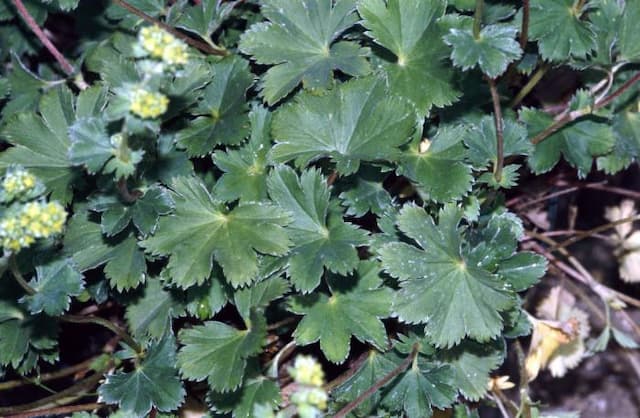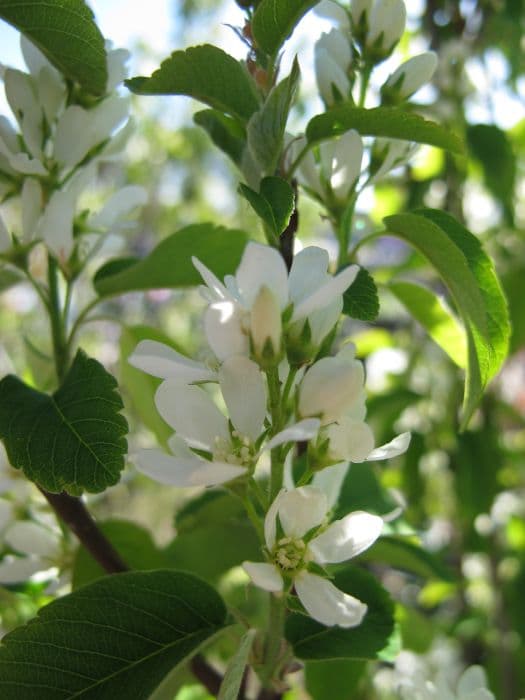Columnar Mountain Ash Sorbus aucuparia 'Fastigiata'

ABOUT
The Sorbus aucuparia 'Fastigiata', more commonly known as the Rowan or Mountain Ash, has a distinct appearance that is eye-catching in various landscapes. This plant stands out with its upright, columnar shape, creating a vertical accent with its elegantly arranged branches. Typically, it produces compound leaves that are pinnately arranged, meaning they feature a series of leaflets arranged on either side of a common stem. The leaves themselves are generally feather-like, with multiple leaflets that exhibit serrated edges, and they are a fresh, vibrant green color that transitions to fiery shades of orange, red, and purple in the fall, providing spectacular autumn color. In the spring, the Rowan bursts into bloom with clusters of small, creamy-white flowers. These flowers are fragrant and appear in dense corymbs, attracting a diverse array of pollinators with their sweet scent and nectar. Boasting both ornamental and ecological value, these flower clusters add a soft, textural contrast to the more rigid form of the tree. Following the flowering period, the plant adorns itself with bright, orange-red berries. These small, spherical fruits are tightly packed into bunches and persist well into the winter months, providing both visual interest in the barren landscape and a valuable food source for birds and wildlife during the colder seasons. The bark of the Rowan has a smooth texture when young and becomes more scaly and ridged as the plant ages. Its color can range from a grayish-brown to a silver-gray, adding another layer of subtle beauty and texture to the plant's overall appearance. Overall, the Rowan is revered for its year-round visual appeal, from the lush foliage and spring blossoms to the vibrant fruit and striking autumn colors.
About this plant
 Names
NamesFamily
Rosaceae.
Synonyms
Rowan, Mountain Ash, European Mountain Ash, Quickbeam.
Common names
Sorbus aucuparia 'Fastigiata'.
 Toxicity
ToxicityTo humans
The common name of Sorbus aucuparia 'Fastigiata' is Rowan. The berries of the Rowan tree have mild toxicity when raw due to the presence of parasorbic acid, which can convert into hydrogen cyanide in the stomach. Consumption of significant quantities of the berries in their raw form can lead to symptoms such as vomiting, diarrhea, abdominal pains, and lethargy. Cooking or drying typically degrades the toxic constituents and can make the berries safe to consume. However, other parts of the plant, including leaves and seeds, are typically not consumed.
To pets
The Rowan tree, as known from its common name, is not commonly listed as a toxic plant for pets. However, due to the mild toxicity of the berries for humans when raw, it is reasonable to exercise caution and discourage pets from ingesting any part of the plant. If pets consume significant quantities of the berries, they might experience gastrointestinal upset, manifested by symptoms like vomiting or diarrhea. As with humans, other parts of the plant such as leaves and seeds are not typically ingested by pets, but if consumed could potentially cause similar symptoms. It is always advisable to monitor pets and prevent them from eating plants not specifically meant for their consumption.
 Characteristics
CharacteristicsLife cycle
Perennials
Foliage type
Deciduous
Color of leaves
Green
Flower color
White
Height
20-25 feet (6-7.5 meters)
Spread
6-8 feet (1.8-2.4 meters)
Plant type
Tree
Hardiness zones
4
Native area
Europe
Benefits
 General Benefits
General Benefits- Ornamental value: The European mountain ash provides visual interest throughout the seasons with white spring flowers, orange-red berries in autumn, and an attractive tree shape.
- Wildlife support: Berries produced by the tree are a valuable food source for birds and other wildlife during the fall and winter.
- Drought tolerance: Once established, it is relatively tolerant to drought, which can be beneficial in dryer climates or during water restrictions.
- Cold hardiness: It is capable of withstanding cold temperatures, making it suitable for planting in many climates, including those with harsh winters.
- Urban adaptability: European mountain ash is tolerant of urban pollution and soil compaction, making it a good choice for city environments.
- Low maintenance: It generally requires minimal pruning and care once established, which is beneficial for gardeners looking for low-maintenance landscaping options.
- Compact growth: The 'Fastigiata' variety has a columnar form, making it ideal for smaller spaces or as a vertical accent in a garden.
 Medical Properties
Medical Properties- Rowan (Sorbus aucuparia 'Fastigiata') berries have been used in folk medicine across Europe. They were believed to have astringent and diuretic qualities.
- The berries were also traditionally used to make syrups or decoctions thought to be high in Vitamin C and to help prevent scurvy.
- In some cultures, the berries were used in treatments for the common cold or flu due to their vitamin content.
- The bark of the rowan tree has been used in traditional medicine for its potential antiseptic properties.
- The flowers, often used in infusions, were believed to have mild laxative effects.
 Air-purifying Qualities
Air-purifying QualitiesThis plant is not specifically known for air purifying qualities.
 Other Uses
Other Uses- Dye production: The berries of Sorbus aucuparia, commonly known as rowan, can be used to make natural dyes for textiles, yielding shades of green when alum is used as a mordant.
- Wildlife shelter: The dense branching of the 'Fastigiata' variant provides excellent cover for birds and small mammals, offering protection from predators and harsh weather.
- Folk art material: The wood of the rowan tree is sometimes used in folk art and crafts for creating small sculptures and decorative items.
- Musical instruments: The hard, dense wood of the rowan tree is occasionally used in the making of certain musical instruments like recorders or wood blocks.
- Photography: The vibrant autumn colors and berry clusters make rowan trees attractive subjects for nature photography, especially in the 'Fastigiata' form with its narrow, upright habit.
- Fishing bait: In some regions, the berries are used as bait in fishing, as their bright color can attract certain types of fish.
- Educational tool: With its distinct seasonal changes, the rowan 'Fastigiata' can serve as an educational tool for teaching about plant life cycles and horticulture.
- Traditional crafts: The berries and leaves of the rowan tree could be used in traditional crafts for making seasonal decorations, like wreaths and garlands.
- Culinary experimentation: While not common, the sour berries of the rowan can be used experimentally in gastronomy to create unique jams, jellies, and sauces when cooked and sweetened appropriately.
- Winter interest: The persistent berries and distinctive form of Sorbus aucuparia 'Fastigiata' provide visual interest in winter gardens, adding color and structure to the landscape.
Interesting Facts
 Feng Shui
Feng ShuiThe Rowan tree is not used in Feng Shui practice.
 Zodiac Sign Compitability
Zodiac Sign CompitabilityThe Rowan tree is not used in astrology practice.
 Plant Symbolism
Plant Symbolism- Protection – The Rowan tree, which Sorbus aucuparia 'Fastigiata' is a cultivar of, is often associated with protection, believed to ward off evil and harmful spirits.
- Wisdom – In Celtic mythology, the Rowan is seen as a tree of wisdom, a symbol of learning and knowledge.
- Life and Vitality – The Rowan's vibrant berries suggest a celebration of life and vitality, reflecting an energy of health and vibrance.
- Magic – Due to its connection to mythology and folklore, the Rowan is also associated with magic and mysticism.
- Healing – Many cultures have used parts of the Rowan tree for healing purposes, symbolizing healing and the ability to overcome challenges.
 Water
WaterThe European Mountain Ash or Rowan should be watered deeply to saturate the root zone, then allowed to dry out slightly before the next watering. During the first growing season, it's critical to maintain a consistent watering schedule, such as once a week, to help establish a strong root system. Generally, watering with 1 to 2 gallons per week depending on rainfall and soil type is advised. Mature trees typically need less frequent watering, and during the cooler months, the Rowan may only need water once every 2 to 4 weeks. It is important to avoid overwatering, as this can lead to root rot.
 Light
LightThe European Mountain Ash thrives in full sun to partial shade conditions. It's best grown in a spot that receives at least 6 hours of direct sunlight daily, while also offering some protection from the hottest part of the afternoon if the climate is particularly warm. A location that gets morning sun and afternoon shade often works well for this tree.
 Temperature
TemperatureThe European Mountain Ash can tolerate a wide range of temperatures, from cold winters to moderate summers. It is hardy and can survive temperatures as low as -30°F and as high as 90°F, but it grows best in cooler climates with temperatures averaging between 50°F and 70°F. They're well-suited for areas that experience distinct seasons.
 Pruning
PruningPruning the European Mountain Ash is important to maintain its health and desired shape. Remove dead, damaged, or crossing branches to prevent disease and improve air circulation. It's recommended to prune in late winter to early spring when the tree is still dormant and before new growth begins. Pruning every 2 to 3 years can keep the Rowan looking neat and prevent the need for more drastic cuts in the future.
 Cleaning
CleaningAs needed
 Soil
SoilThe European Mountain Ash 'Fastigiata' prefers a well-drained, loamy soil enriched with organic matter. The ideal soil pH for this plant ranges between 5.5 and 6.5. A mix of garden soil, compost, and peat can make a suitable soil base for this cultivar.
 Repotting
RepottingEuropean Mountain Ash 'Fastigiata' being a tree, is usually not repotted. Instead, it is planted in a permanent location where it can grow without the need for repotting.
 Humidity & Misting
Humidity & MistingEuropean Mountain Ash 'Fastigiata' is adaptable and does not require special humidity conditions; average outdoor humidity is suitable for this tree.
 Suitable locations
Suitable locationsIndoor
Not ideal for indoors; requires full sun, ample space.
Outdoor
Plant in full sun, well-draining soil, space to grow.
Hardiness zone
4-7 USDA
 Life cycle
Life cycleThe European Rowan 'Fastigiata' begins its lifecycle as a seed, which upon germination in favorable conditions—moist, well-drained soil—develops into a seedling. As the seedling establishes, it grows into a young sapling, characterized by its upright, columnar growth habit. Over the years, it matures into an adult tree, reaching heights of up to 10-15 meters, with pinnate leaves and a distinctive, narrow crown. The tree flowers in spring, bearing clusters of white flowers, which are pollinated by insects. Following pollination, the flowers develop into orange-red berries by autumn, which are then dispersed by birds and other wildlife, completing its reproductive cycle. The European Rowan 'Fastigiata' can live for several decades, during which time it may face various environmental stresses, such as pests, diseases, and adverse weather conditions that can influence its growth and lifespan.
 Propogation
PropogationPropogation time
Late Winter to Early Spring
The European Mountain Ash 'Fastigiata', or Rowan Tree, can be propagated through seeds or more commonly by grafting. The most popular method of propagation for this cultivar is grafting, which is typically done in late winter or early spring when the plant is still dormant. Grafting involves taking a young twig or bud, known as a scion, from the Rowan Tree and attaching it to the rootstock of a related species that provides support and nutrients. The scion should be carefully matched and fixed to the rootstock using grafting tape or wax to ensure a snug join. Over time, ideally within a few weeks to a couple of months, the grafted joint knits together as the tissues grow, leading to a single, viable plant that combines the desirable characteristics of the 'Fastigiata' with the vigor and hardiness of the rootstock.









